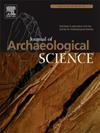Dual role of human activities and climate in pre-industrial nitrogen shifts in Ireland
IF 2.5
1区 地球科学
Q1 ANTHROPOLOGY
引用次数: 0
Abstract
Past research has uncovered a shift in herbivore collagen δ15N values during the Middle to Late Bronze Age (3700–2750 BP) in Ireland, attributed to intensified land-use - another example in a growing body of evidence that suggests that the Anthropocene concept (whereby humans have made significant impacts to the Earth's systems) began far earlier than previously thought (the ‘Palaeoanthropocene’). While human activity was clearly an important driver of this shift, it remains possible that climate may also have played a role. In Ireland, this shift in δ15N appeared to be sustained despite subsequent reforestation, suggesting that Bronze Age and later peoples left a profound biogeochemical mark on the environment. Here, we revisit this topic, presenting new stable isotope (δ15N and δ13C) measurements from directly radiocarbon-dated wild and domesticated adult herbivorous ungulate bones from the Bronze and Iron Ages, with the aim of constraining the timing of this shift and disentangling the role of human land use from climatic influences. A sustained nitrogen isotopic shift was constrained to ca. 3000 cal BP. Notably, during the Iron Age, a time of widespread reforestation, wild and domesticated herbivorous ungulates exhibited δ15N values that were not significantly different from one another. This suggests that, while the δ15N shift was initiated by land-use change, climate variability, particularly shifts towards warmer and drier conditions during the Late Bronze/Iron Age transition and later Iron Age, may have contributed to its persistence. This study refines the chronology of nitrogen cycle changes in Ireland, demonstrating that human activity initiated a long-term shift in δ15N values during the Late Bronze Age, but that climatic factors may have played a role in maintaining elevated δ15N values during periods of reduced land use. These findings underscore the complexities of understanding the nitrogen cycle in ancient environments and highlight the potential interplay between anthropogenic and environmental drivers of biogeochemical change.
人类活动和气候在爱尔兰工业化前氮转移中的双重作用
过去的研究发现,爱尔兰青铜器时代中晚期(3700-2750 BP)食草动物胶原蛋白δ15N值的变化归因于土地利用的集约利用——这是另一个例子,越来越多的证据表明,人类世的概念(人类对地球系统产生了重大影响)比以前认为的要早得多(“古人类世”)。虽然人类活动显然是这种转变的重要驱动因素,但气候也可能发挥了作用。在爱尔兰,尽管后来进行了重新造林,但δ15N的变化似乎仍在持续,这表明青铜时代和后来的人类在环境中留下了深刻的生物地球化学印记。在这里,我们重新审视了这个话题,提出了新的稳定同位素(δ15N和δ13C)测量结果,这些测量结果来自青铜和铁器时代的野生和驯化的成年食草有蹄类动物的骨骼,目的是限制这种转变的时间,并将人类土地利用的作用与气候影响分开。持续的氮同位素转移被限制在约3000 cal BP。值得注意的是,在铁器时代,野生和驯化草食性有蹄类动物的δ15N值没有显著差异。这表明,虽然δ15N变化是由土地利用变化引起的,但气候变率,特别是青铜/铁器时代晚期和铁器时代晚期向温暖和干燥条件的转变,可能有助于其持续存在。这项研究完善了爱尔兰氮循环变化的年代学,表明人类活动在青铜时代晚期引发了δ15N值的长期变化,但在土地利用减少的时期,气候因素可能在维持δ15N值升高方面发挥了作用。这些发现强调了理解古代环境中氮循环的复杂性,并强调了生物地球化学变化的人为和环境驱动因素之间潜在的相互作用。
本文章由计算机程序翻译,如有差异,请以英文原文为准。
求助全文
约1分钟内获得全文
求助全文
来源期刊

Journal of Archaeological Science
地学-地球科学综合
CiteScore
6.10
自引率
7.10%
发文量
112
审稿时长
49 days
期刊介绍:
The Journal of Archaeological Science is aimed at archaeologists and scientists with particular interests in advancing the development and application of scientific techniques and methodologies to all areas of archaeology. This established monthly journal publishes focus articles, original research papers and major review articles, of wide archaeological significance. The journal provides an international forum for archaeologists and scientists from widely different scientific backgrounds who share a common interest in developing and applying scientific methods to inform major debates through improving the quality and reliability of scientific information derived from archaeological research.
 求助内容:
求助内容: 应助结果提醒方式:
应助结果提醒方式:


